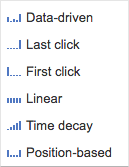The mother of all attribution models
 If you understand the concept of attribution, and have experience using Google Analytics’ Multi-Channel Funnels reports, you know that selecting the right attribution model is important in making decisions about budget distribution and optimization focus.
If you understand the concept of attribution, and have experience using Google Analytics’ Multi-Channel Funnels reports, you know that selecting the right attribution model is important in making decisions about budget distribution and optimization focus.
While the default Google Analytics attribution models are useful, the most powerful is the data-driven attribution model – which is only available with paid Google Analytics 360 Suite product licenses. If you are using the free Google Analytics product, does that mean you just have to do without data-driven attribution? Regarding Google Analytics, yes – but there is another path. If you are a Google AdWords customer – data-driven attribution modelling may be available to help you manage your paid advertising, if your account meets the requirements.
How AdWords data-driven attribution works
Data-driven attribution uses your conversion data to calculate the actual contribution of each keyword across the conversion path. Each data-driven model is specific to each advertiser.
AdWords looks at all the clicks on your Google Search ads. By comparing the click paths of users who convert to the paths of user that don’t, the model identifies patterns among those clicks that lead to conversions. There are certain steps along the way that have a higher probability of leading a customer to complete a conversion. The model then gives greater credit to those valuable clicks along the path to conversion. If you use an AdWords automated bid strategy, it will use this important information to help you get more conversions.
Like the other attribution models that can be applied to AdWords conversion actions, data-driven attribution is only available for google.com search ads, and only for website and Google Analytics conversion actions.
Data requirements
For the data-driven attribution model to be available, an account must have at least 15,000 clicks and a conversion action must have at least 600 conversions within 30 days. Preparation for the data-driven model begins the moment you receive the minimum necessary attribution data. Once sufficient data has been collected for the model for 30 consecutive days, you will see the data in AdWords. You may see data-driven attribution for some of your website and Google Analytics conversion actions, and not for others.
You won’t be able to continue using this model if your data drops below 10,000 clicks for the account or 400 conversions for the conversion action within 30 days. You’ll receive an alert when your data drops below this level, and, after 30 days of continued low data, your conversion action will be switched to a linear attribution model. If data-driven attribution isn’t available to you, AdWords offers other attribution models that don’t have data requirements.
Cross-account conversion tracking
If you use cross-account conversion tracking to track conversions at the manager account level, you can meet data requirements based on aggregate click & conversion data across all accounts where a given conversion action is active.
AdWords data-driven attribution methodology
There are two main parts to the data-driven attribution methodology: (1) analyzing the available path data to develop custom conversion probability models, and (2) applying to that probabilistic data set a sophisticated algorithm that assigns fractional conversion credit to your marketing touchpoints.
Develop conversion probability models from available path data
Data-driven attribution uses the available path data—including data from both converting and non-converting users—to understand how the presence of particular marketing touchpoints impacts your users’ probability of conversion. The resulting probability models show how likely a user is to convert at any particular point in the path, given a particular sequence of paid search clicks.
Algorithmically assign conversion credit to marketing touchpoints
Data-driven attribution then applies to this probabilistic data set an algorithm based on a concept from cooperative game theory called the Shapley Value. The Shapley Value was developed by the economics Nobel Laureate Lloyd S. Shapley as an approach to fairly distributing the output of a team among the constituent team members.
In the case of data-driven attribution in AdWords, the “team” being analyzed has AdWords paid search clicks (for example, Campaign A, Campaign B) as “team members,” and the “output” of the team is conversions. The data-driven attribution algorithm computes the counterfactual gains of each AdWords paid search click—that is, it compares the conversion probability of similar users who were exposed to these clicks, to the probability when one of the clicks does not occur in the path.
The actual calculation of conversion credit for each touchpoint depends on comparing all of the different permutations of touchpoints and normalizing across them. This means that the data-driven attribution algorithm takes into account the order in which each touchpoint occurs and assigns different credit for different path positions. For example, Campaign A preceding Campaign B is modeled separately from Campaign B preceding Campaign A.
Example
In the following high-level example, the combination of Campaign A, Campaign B, Campaign C leads to a 3% probability of conversion. When Campaign A is removed, the probability drops to 2%. The observed 50% increase when Campaign A is present serves as the basis for attribution.

Explore your data-driven model and select it for reporting/bidding
Use the Attribution Modeling report to compare models and to identify optimization opportunities. Once you’ve decided you want to switch one or more of your conversion actions to the data-driven model, go ahead and select the model to use it for reporting/bidding in AdWords.
Reference:
https://storage.googleapis.com/support-kms-prod/ruzJsY6XnPz7wrb78ErBpdRGBohoI7HPxh3o